Scratch Big Head Pete's Oscar Original Design / Scratch Built
Scratch - Big Head Pete's Oscar {Scratch}
Contributed by Pete Lilja
| Manufacturer: | Scratch |
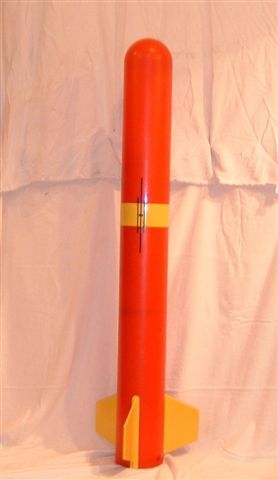 Brief:
Brief:
Being the kind of guy that likes unusual rockets I decided to scratch build a
bird the likes of which have only been seen once before. During the Summer of
2002 I watched the LDRS XX videotape from
Extreme Rocketry. In the video is
a segment of Bruce O'Brien's 'Homer'
all plastic rocket made from a post cover sleeve much like you see protecting
the concrete and steel posts at drive-through restaurants. I was intrigued by
the idea of a non-standard material scratch-built rocket. I've shamelessly
stolen Bruce's idea and made my own version dubbed 'Oscar' (as a fellow rocket
club member said it looks like a hot dog with mustard on it due to its red body
and yellow fins).
Construction:
I used a 55½" X 6¼" bollard post shield from
Ideal Shield
purchased from the friendly local manager of a national discount chain store
who had one to spare.
Parts List:
- Fiberglassed ½" fins
- 60" Sky Angle parachute
- 24" Sky Angle drogue
- Two 30' shock cords
- Shock cord protectors
- Nomex® parachute protectors
- Forged eye bolts
- Delta Quick-links
- 4 #2 shear pins
- Plastic rivets
- Altimeter
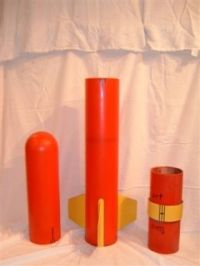
The building of the rocket was rather straight forward but time consuming as all parts had to be custom made due to the non-standard size of the body-tube component. I first cut centering rings from ½" & \" plywood and sized for a 98mm fiberglass motor mount tube. There are three centering rings and TTW to the MMT fins laid out in RockSim. The fin slots were cut on a table saw using a plywood box jig to cut them straight.
The plastic used is very easy to work with ordinary woodworking tools. My biggest problem was cutting the body tube square for the booster section/altimeter bay/nosecone sections. Fortunately I was able to have a local machine shop cut the sections perfectly on their large horizontal band saw at no charge.
The coupler section is simply a piece of the same material with a strip cut longitudinally to make the outside diameter the same as the inside diameter of the booster tube. (See INFOcentral for more information on how to do this.)
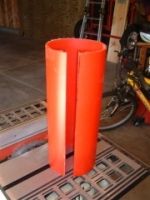
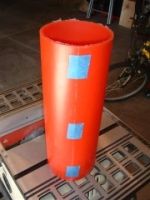
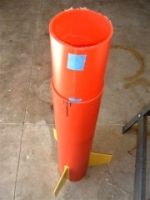
Fiberglass cloth and epoxy were used to rejoin the section after a run of a 60 grit sanding drum on my Dremel tool. The altimeter bay is large enough that I was able to place two 54mm tubes side-by-side in the center section. This allows for two altimeters and their inherent redundancy.
The fins are through-the-wall-to-the-motor-mount-tube and of fiberglassed ¼" aircraft plywood. All joints are epoxied and the area between the aft two centering rings filled with two part foam.
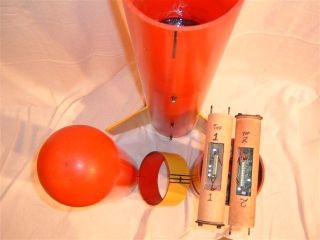 There are two 30'
shock cords which connect the center coupler tube/altimeter bay with the
booster section with the 24" Sky Angle drogue and to the nosecone section
which carries the 60" Sky Angle main parachute. Forged eye-bolts used on
all attachment points.
There are two 30'
shock cords which connect the center coupler tube/altimeter bay with the
booster section with the 24" Sky Angle drogue and to the nosecone section
which carries the 60" Sky Angle main parachute. Forged eye-bolts used on
all attachment points.
Four #2-56 nylon screw shear pins per payload and booster section are used. Ground testing determined that five grams of ffffg black powder doubles the required amount of BP to consistently separate the body sections for deployment. These canisters are ignited by the G-Wiz LC 800 which deploys the drogue and main. Plastic, removable rivets retain the body tube section which centers the coupler tube/altimeter bay but still allow it to be slid out of the way to gain access to the 'window' into the altimeter bay for continuity check and the arming of the ejection charges.
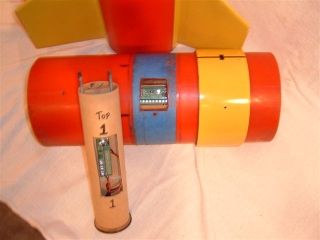
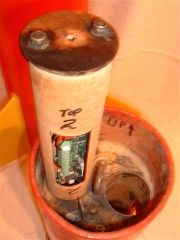
Three rail buttons screwed directly into the three centering rings hold Oscar upright on the pad. Because this plastic material is translucent finding the centering rings is easy to do. I simply dropped an incandescent trouble light in the airframe and the centering rings cast a shadow. I then drilled into the dark area to hit the wood.
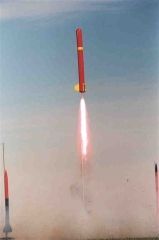
Flight:
This rocket was fun to build and is very fun to fly. People ask just what it is
as most have never seen anything quite like it. As of this writing, it has
flown three times all on CTI Pro54 K570 motors and dual deployment. Since it is
quite heavy at 22 pounds loaded weight (I can't seem to build a lightweight
rocket!), it had a relatively slow lift-off. But the motor easily pushes the
rocket up and up to about 3,500'.
The first flight was almost picture perfect. It climbed to apogee and the drogue chute popped flawlessly. It descended under the drogue nicely and at what appeared to be 800' the G-wiz LC800 altimeter set off the charge for the main. We could see separation of the airframe but the 'chute didn't open. I watched helplessly as Oscar hit the ground at a pretty high rate of speed. I walked to recover the rocket over the empty early Spring Iowa beanfield to find a completely undamaged Oscar. It was evident right away what the problem was with the main chute not opening. In an oversight I had tied the parachute attachment loop too close to the nosecone and there was simply not enough length of cord to fully pull free the main. It was an easy fix and a lesson learned. It is also a testament to the strength of the bollard post shield in that a 20+ pound rocket fell from 3,500' under a 24" drogue only and suffered nothing but a bit of cosmetic damage.
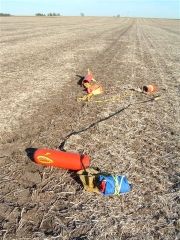 Flight number two
went from a 12' rail. This flight was a bit different than the first. The
rocket oscillated a bit on boost and angled a bit into the wind. I lost sight
of the flight but the LCO called out that it had past apogee with no visible
chute. It kept falling and falling and others began calling out there was no
laundry visible. Finally, after several seconds of a ballistic recovery the
drogue charge blew. By this time the rocket was descending at a rather high
speed and when the drogue came out and slowed the ship relatively quickly all
of the shear pins let go and the main came out too. It was a violent
deployment. This walk to retrieve Oscar was long--GPS measured it as .8 mile
straight and through a knee deep drainage ditch. Once again there was no damage
to the rocket. The shock cords appeared to have taken a good jolt as there were
twisted up tightly and the Nomex®
parachute protectors were all pulled and had slid down the shock cord. This
plastic airframe is tough stuff.
Flight number two
went from a 12' rail. This flight was a bit different than the first. The
rocket oscillated a bit on boost and angled a bit into the wind. I lost sight
of the flight but the LCO called out that it had past apogee with no visible
chute. It kept falling and falling and others began calling out there was no
laundry visible. Finally, after several seconds of a ballistic recovery the
drogue charge blew. By this time the rocket was descending at a rather high
speed and when the drogue came out and slowed the ship relatively quickly all
of the shear pins let go and the main came out too. It was a violent
deployment. This walk to retrieve Oscar was long--GPS measured it as .8 mile
straight and through a knee deep drainage ditch. Once again there was no damage
to the rocket. The shock cords appeared to have taken a good jolt as there were
twisted up tightly and the Nomex®
parachute protectors were all pulled and had slid down the shock cord. This
plastic airframe is tough stuff.
The third flight was picture perfect. The launch rail was angled slight upwind and the boost was perfect. At apogee the ejection charge blew and I got a good separation. This time I had left the drogue out and hoped for a horizontal fall of the two airframe pieces (because of a rather windy day). While the nosecone section fell nose down and with the booster section trailing behind. At 800' the charge released the main parachute for a picture perfect descent a few hundred yards in front of me right on the sod farm. It was another great flight by Oscar.

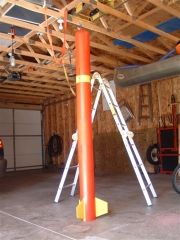
Since the write of the first three flights, Oscar has flown 7 more times during the summer and fall of 2003. I've added another altimeter and used the K660 Pro54 6 grain motor. The K660 kicks the rocket quite nicely to about 4,300 feet. It has also been flown on an EX L1300 to 8,000' and in an extended configuration, an EX M2000. All flights were successful except for the last flight of the year when on another K660 I mispacked the main chute and the rocket fell from about 4,000' onto a freshly picked Midwestern soybean field. The heavy rocket hit hard yet the only damage sustained was one cracked fin. The fin has since been replaced.
Summary:
This rocket has been a tremendously fun to build and fly. It is big, tough and
an eye-catcher. People frequently ask just what it is made from as it is so
unusual. If you are looking for a scratch built project this may be the one for
you. Both smaller and larger tubes are available if you want to make a
mid-power flier or an even bigger rocket.
This plastic material is easy to work with. I have a few 'extra' pieces of the tubing and made a 16" extension for flying large motors. This extension is simply a coupler tube and airframe section placed above the booster section and screwed into place. It is modular and can be easily added or removed for differing motor configurations.
Sponsored Ads
 |
 |











